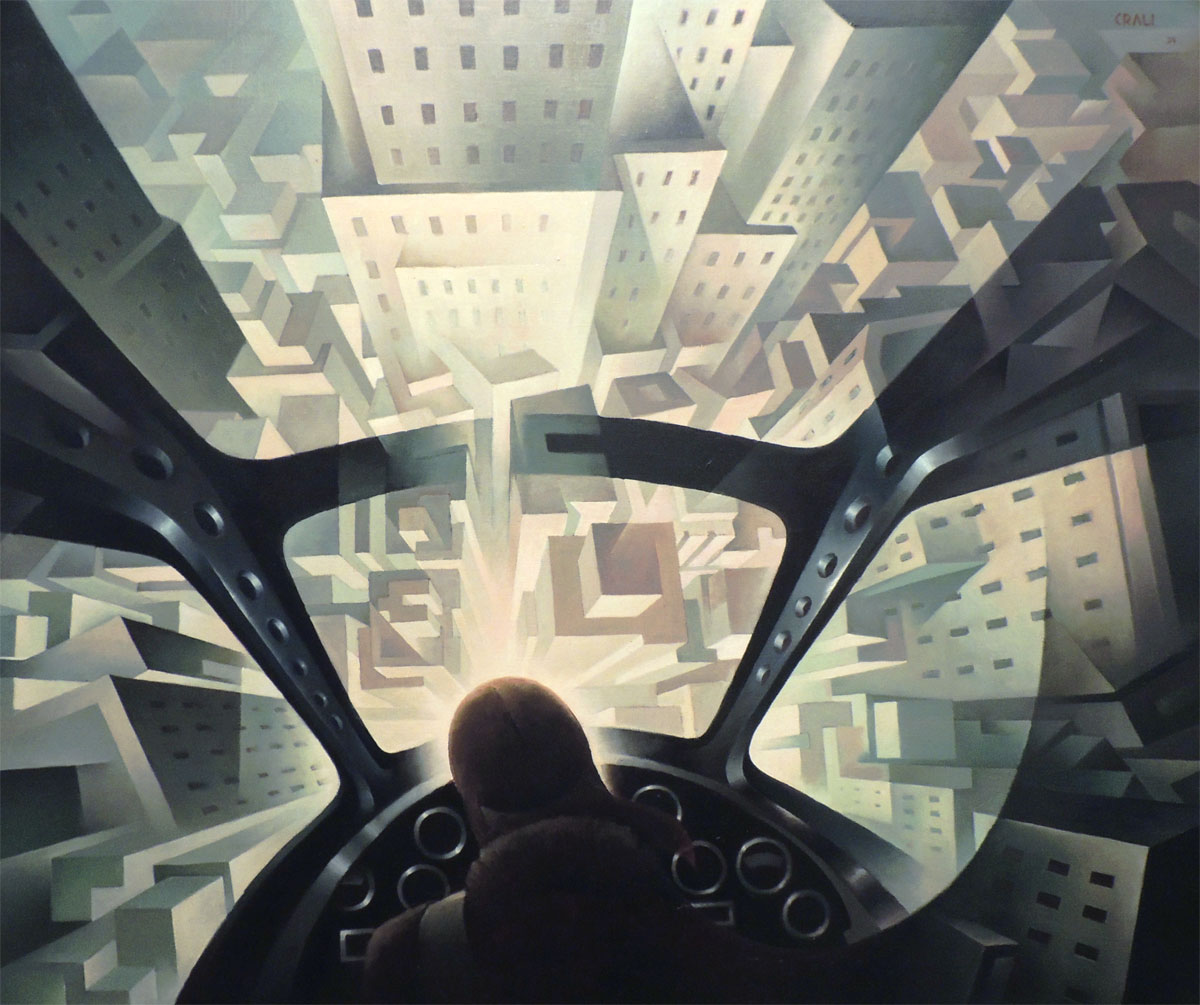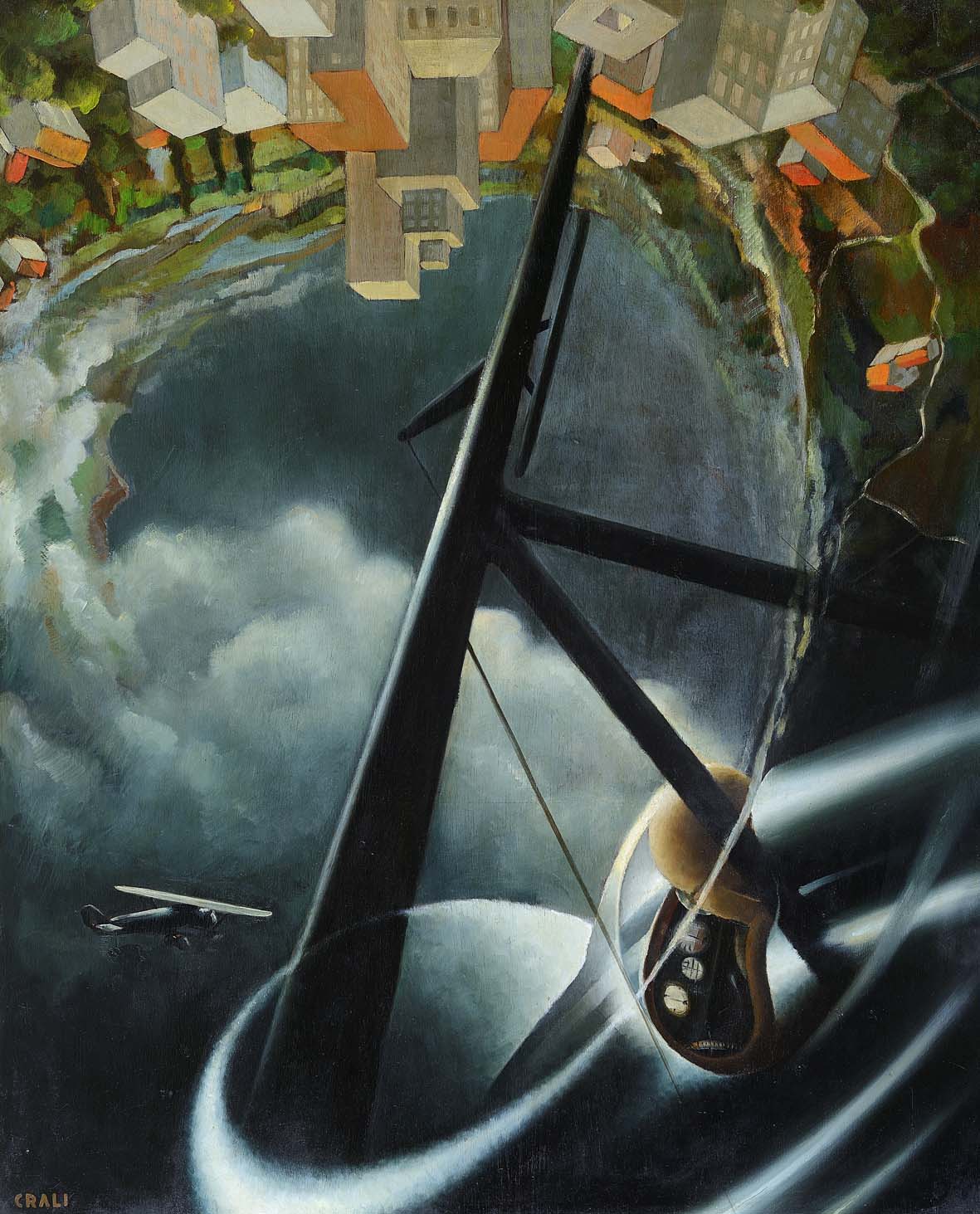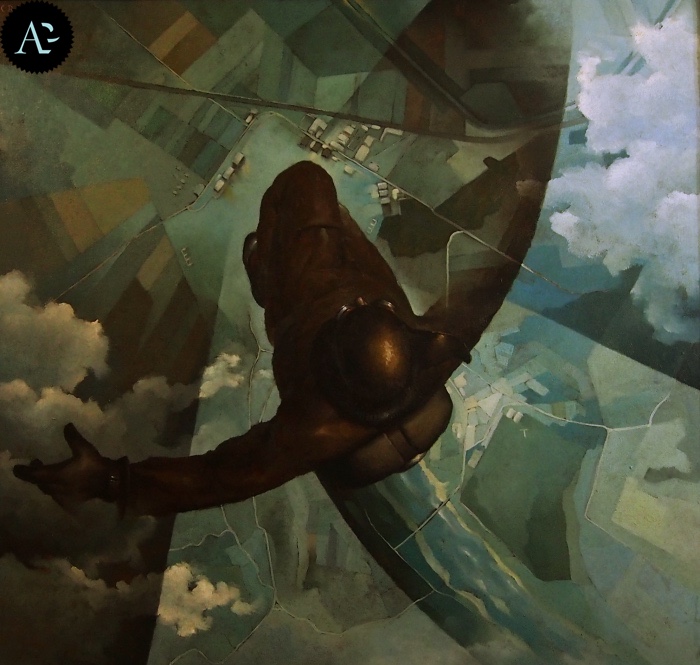Futurismo e Aeropittura: la rivoluzione artistica che trasformò il mondo

Tullio Crali, Incuneandosi nell’abitato. Tuffo sulla citta
Hai mai sentito parlare di Futurismo e Aeropittura? Ma soprattutto, sai quali sono le radici storiche e culturali che hanno dato vita a questi rivoluzionari movimenti artistici?
Mentre il XIX secolo si chiudeva in Italia in un clima di crescente agitazione sociale e tensione autoritaria, il Futurismo nacque come una tempesta culturale, pronta a travolgere tutto. Questa fase storica vide un’Italia sottoposta a un rapido sviluppo industriale ma anche alle sfide poste da deficit infrastrutturali e disparità economiche, specialmente nelle regioni meridionali. Vediamo insieme quale fu il terreno su cui nacque l’aeropittura.
Futurismo e Aeropittura: la rivoluzione artistica che trasformò il mondo

Tullio Crali – Aerocaccia I (Duello di caccia), 1936, olio su tavola, 80×100 cm
Il contesto storico in cui nacque il Futurismo è quello della Prima Guerra Mondiale. Questo è il momento in cui la guerra, la battaglia ma anche una fiducia sconfinata nel futuro provocarono grandi tensioni e passioni presenti.
FILIPPO TOMMASO MARINETTI: IL PROFETA DEL FUTURISMO
Filippo Tommaso Marinetti fu il catalizzatore di questa corrente artistica, dando vita al Manifesto del Futurismo.
Proveniente da una famiglia borghese e trasferitosi a Milano, Marinetti utilizzò il suo status e il suo patrimonio per promuovere il Futurismo, optando per Parigi come “teatro” per il debutto.
In una Francia già effervescente di movimenti d’avanguardia, il suo manifesto scagliava un’accusa forte contro l’immobilismo culturale italiano. Il Futurismo si configurava come un culto della modernità, delle macchine, della velocità, e addirittura glorificava la guerra come purificatrice sociale.
ESTETICA E IDEOLOGIA: OLTRE LA PITTURA
Il movimento futurista non si limitava all’arte e alla letteratura; estendeva la sua influenza alla musica, al teatro e perfino alla politica.
La ‘tecnica del manifesto’, esposta in documenti come il “Manifesto dei pittori futuristi” e il “Manifesto tecnico”, sosteneva un’estetica che privilegiava il dinamismo e il movimento, in contrapposizione alle forme accademiche e tradizionali.
Al centro di tutto c’era la macchina, vista come estensione della forza umana e come simbolo dell’era industriale. Il Futurismo era, in poche parole, un movimento totalizzante che cercava di raggiungere il pubblico attraverso spettacoli teatrali, declamazioni e campagne pubblicitarie.
“La Ricostruzione Futurista dell’Universo” è un manifesto fondamentale firmato dagli artisti Giacomo Balla e Fortunato Depero.
Questo documento è essenziale per comprendere la filosofia futurista, in quanto ambiva a rimodellare l’intero universo artistico e materiale. Tendeva a coinvolgere tutti gli aspetti della vita quotidiana, dall’architettura alla pittura, dalla scultura alla musica, fondendo tutto in un “complesso plastico”, un oggetto artistico multidisciplinare destinato a coinvolgere tutti i sensi.
L’AEROPITTURA
L’Aeropittura è un sottogenere del Futurismo, nato in Italia negli anni ’20, dopo la conclusione della Prima Guerra Mondiale. Questo stile artistico è centrato sull’aereo come simbolo di libertà, una libertà negata per molti anni a causa della guerra.
Questa forma d’arte rompe con la prospettiva tradizionale, presentando elementi in costante movimento. In queste opere, i dettagli sono volutamente omessi, lasciando spazio a figure distorte e comprimate.
L’origine dell’Aeropittura è strettamente legata all’immagine dell’aviatore, l’individuo che gode di una libertà senza confini e che domina lo spazio aereo.
Questo movimento possiede anche un suo manifesto: Il “Manifesto dell’Aeropittura Futurista” di Filippo Tommaso Marinetti, apparso per la prima volta nel 1929 sulla Gazzetta del Popolo.
L’obiettivo principale dell’Aeropittura è trasmettere allo spettatore le emozioni e le sensazioni provate durante il volo, come la vastità dello spazio e l’ebbrezza della velocità. Uno degli artisti più noti dell’aeropittura è Tullio Crali, che ha combinato la sua passione per l’arte con quella per il volo, incluso il volo acrobatico.
Tra le sue opere più famose ci sono “Incuneandosi nell’abitato” del 1939, conosciuto anche come “In tuffo sulla città”, e “Prima che si apra il paracadute”, un olio su tela del 1939 attualmente conservato alla Galleria d’Arte Moderna di Udine.

Tullio Crali, Prima che si apra il paracadute (1939). Casa Cavazzini
L’Aeropittura rappresenta un capitolo affascinante e innovativo nell’evoluzione dell’arte moderna e del Futurismo italiano. Va oltre le convenzioni artistiche tradizionali per catturare la dinamicità, la velocità e, soprattutto, la libertà incarnata dal volo e dall’era delle macchine.
Anche se il contesto storico, segnato da due conflitti mondiali, ha avuto un impatto significativo sul corso del Futurismo, l’Aeropittura dimostra come l’arte può trascendere i limiti temporali e spaziali, offrendo una visione che sfida e arricchisce le percezioni tradizionali del mondo. Gli artisti come Crali, fedeli alla loro missione nonostante le turbolenze storiche, sono un testamento alla resilienza e alla continua rilevanza degli ideali futuristi.
Seguimi su:
About me
In questo blog non ti spiego la storia dell’arte, ma racconto le storie di cui parla l’arte


